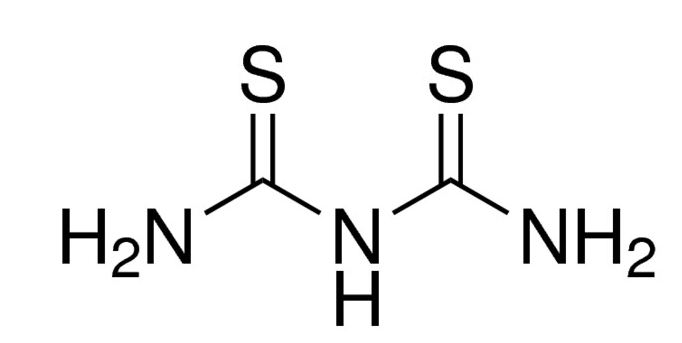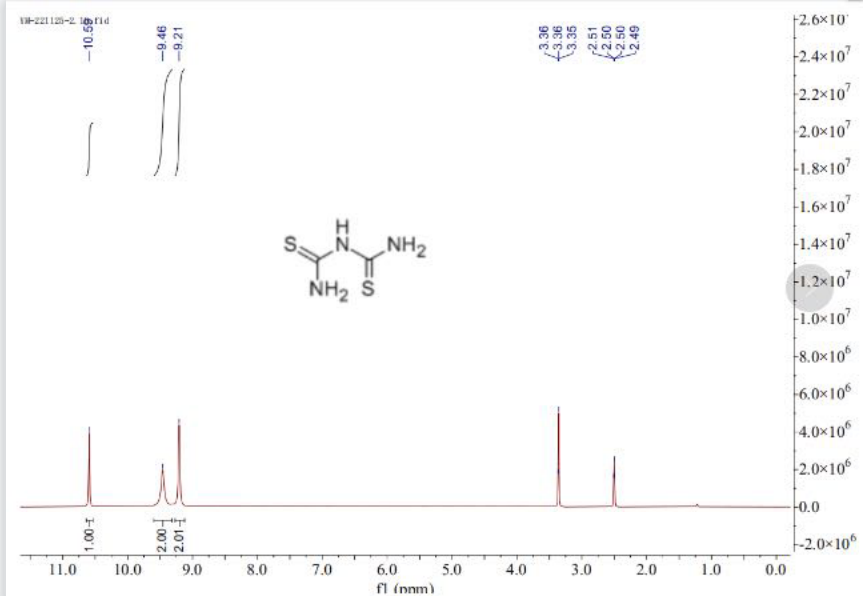Dithiobiuret CAS#: 541-53-7; ChemWhat Code: 794679
Identification
| Product Name | Dithiobiuret |
| IUPAC Name | carbamothioylthiourea |
| Molecular Structure |  |
| CAS Registry Number | 541-53-7 |
| EINECS Number | 208-784-8 |
| MDL Number | MFCD00037832 |
| Beilstein Registry Number | No data available |
| Synonyms | 2,4-Dithiobiuret |
| Molecular Formula | C2H5N3S2 |
| Molecular Weight | 135.211 |
| InChI | InChI=1S/C2H5N3S2/c3-1(6)5-2(4)7/h(H5,3,4,5,6,7) |
| InChI Key | JIRRNZWTWJGJCT-UHFFFAOYSA-N |
| Canonical SMILES | C(=S)(N)NC(=S)N |
| Patent Information | ||
| Patent ID | Title | Publication Date |
| JP2021/1123 | PRODUCTION METHOD OF THIOUREA | 2021 |
| US3998894 | Manufacture of 1-methyl-3-(monohalogeno)-phenylindans and dihalogeno-1-methyl-3-phenylindans | 1976 |
Physical Data
| Appearance | White powder |
| Solubility | No data available |
| Flash Point | No data available |
| Refractive index | 1.5800 (estimate) |
| Sensitivity | No data available |
| Melting Point, °C | Solvent (Melting Point) |
| 186 | H2O |
| 180 – 181 | |
| 189 – 191 | |
| 183 – 185 |
| Description (Association (MCS)) | Solvent (Association (MCS)) | Temperature (Association (MCS)), °C | Partner (Association (MCS)) |
| Stability constant of the complex with … | propan-1-ol | 24.9 | nitrobenzene |
| UV/VIS spectrum of the complex | propan-1-ol | 24.9 | nitrobenzene |
Spectra
| Description (NMR Spectroscopy) | Nucleus (NMR Spectroscopy) | Comment (NMR Spectroscopy) |
| Chemical shifts | 1H | chloroform-d1 |
| NMR | 1H | |
| NMR | 15N |
| Description (IR Spectroscopy) | Solvent (IR Spectroscopy) | Comment (IR Spectroscopy) |
| Bands | 3345 – 634 cm**(-1) | |
| Bands | KBr | 3350 – 706 cm**(-1) |
| Bands | nujol | 397 – 104 cm**(-1) |
| Description (UV/VIS Spectroscopy) |
| UV/VIS |
| Absorption maxima |
Route of Synthesis (ROS)
| Conditions | Yield |
| With ammonium hydroxide; ammonium chloride In water at 90℃; for 10h; | 99% |
Safety and Hazards
| Pictogram(s) |  |
| Signal | Danger |
| GHS Hazard Statements | H300 (100%): Fatal if swallowed [Danger Acute toxicity, oral] H310 (89.13%): Fatal in contact with skin [Danger Acute toxicity, dermal] H330 (89.13%): Fatal if inhaled [Danger Acute toxicity, inhalation] Information may vary between notifications depending on impurities, additives, and other factors. |
| Precautionary Statement Codes | P260, P262, P264, P270, P271, P280, P284, P301+P316, P302+P352, P304+P340, P316, P320, P321, P330, P361+P364, P403+P233, P405, and P501 (The corresponding statement to each P-code can be found at the GHS Classification page.) |
Other Data
| Transportation | Under the room temperature and away from light |
| HS Code | 293090 |
| Storage | Under the room temperature and away from light |
| Shelf Life | 1 year |
| Market Price | USD |
| Druglikeness | |
| Lipinski rules component | |
| Molecular Weight | 135.214 |
| logP | -0.778 |
| HBA | 3 |
| HBD | 3 |
| Matching Lipinski Rules | 4 |
| Veber rules component | |
| Polar Surface Area (PSA) | 128.25 |
| Rotatable Bond (RotB) | 2 |
| Matching Veber Rules | 2 |
| Use Pattern |
| enhancing permeation of the anticholinergic or antispasmodic agent. |
| Component of composition for topical or transdermal administration. |
Buy Reagent | |
| No reagent supplier? | Send quick inquiry to ChemWhat |
| Want to be listed here as a reagent supplier? (Paid service) | Click here to contact ChemWhat |
Approved Manufacturers | |
| Warshel Chemical Ltd | http://www.warshel.com/ |
| Want to be listed as an approved manufacturer (Requires approvement)? | Please download and fill out this form and send back to approved-manufacturers@chemwhat.com |
Other Suppliers | |
| Watson International Limited | Visit Watson Official Website |
Contact Us for Other Help | |
| Contact us for other information or services | Click here to contact ChemWhat |



